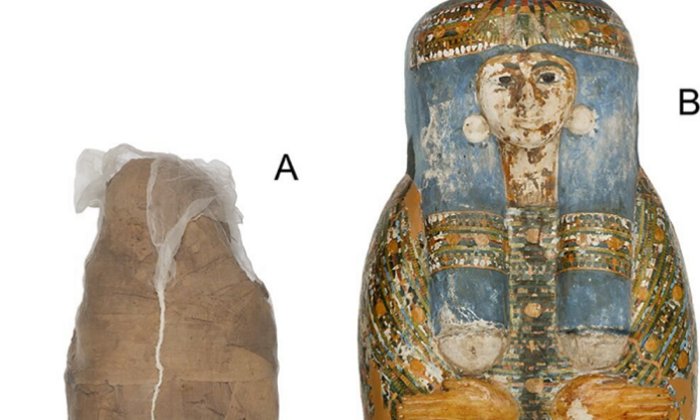Conny Waters - AncientPages.com - Studies of mummified bodies from the late New Kingdom to the 21st Dynasty (c. 1294-945 BC) have occasionally reported a hard resinous shell protecting the body within its wrappings, especially for royal mummies of the period.
Mummified individual and coffin (the Nicholson Collection of the Chau Chak Wing Museum (Sowada et al/PLOS One)
A new study by Karin Sowada from Macquarie University, Sydney, Australia, and colleagues, describe their discovery of a rare painted mud carapace enclosing an adult mummy in Sydney's Chau Chak Wing Museum.
The team also suggests that "the mud shell encasing the body of a mummified woman within the textile wrappings is a new addition to our understanding of ancient Egyptian mummification."
Sir Charles Nicholson bought the mummified body, lidded coffin, and mummy board as a set during a trip to Egypt in 1856-7, donating it to the University of Sydney in 1860.
The coffin inscription identifies the owner as a titled woman named Meruah, and the iconography dates it to approximately 1000 BC.
Though the mummified individual underwent a full computed tomography (CT) scan in 1999, the authors rescanned the body for the current study using updated technology.
They also determined the mummified individual was a young middle adult (26-35 years).
Though the body scans did not reveal external genitalia, and internal reproductive organs had been removed during the mummification process, osseous secondary sexual characteristics (hip bones, jaw, and cranium) strongly suggest the mummified individual was female.
The current analysis of the mummification technique and radiocarbon dating of textile samples from the linen wrappings suggests the mummified individual is dated to the late New Kingdom (c. 1200-1113 BC).
This means the body is older than the coffin, suggesting local 19th-century dealers placed an unrelated body in the coffin to sell as a complete set.
The new scans also revealed the extent and nature of the mud carapace, showing the mud shell fully sheaths the body and is layered within the linen wrappings. Additionally, images of the inmost layers indicate the body was damaged relatively shortly after initial mummification, and the mud carapace and additional wrappings applied to reunify and restore the body.
Written by Conny Waters - AncientPages.com Staff Writer
